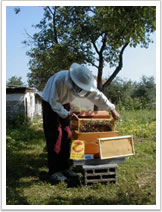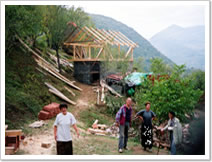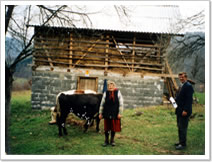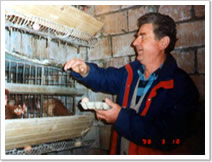

In 1994, when JEN began its activities in the former Yugoslavia, the conflict in Bosnia Herzegovina was still raging, and there were many refugees in both Croatia and Serbia Montenegro. Holding fears that they “would not be able to return home” in their protracting lives as refugees, the refugees were in need of psychological care and assistance for self-support.
After the peace accord that was signed in December 1995, many refugees and IDPs began to resettle in Bosnia. Needs to rebuild people's lives therefore were high, as well as promote the return of minorities.
In 1998, with the intensification of the Kosovo conflict, new refugees and IDPs emerged. This was only exacerbated with the NATO bombings, as more and more people newly became refugees or IDPs in areas where aid was seldom.
Even after the latter half of 1999, when the conflict had finally died down, problems remained in abundance: the reestablishment and reconstruction of a land completely destroyed, the resettlement of returnees, and the settling in of refugees in their respective host countries.



The eruption of conflict, and the tragedy of the Federal Republic of Yugoslavia

Following the death of President Tito (Josip Broz), who had made efforts in maintaining the federal system of the country, the Federal Republic of Yugoslavia was faced with the transition from communism to democracy as well as a market economy. Such dramatic change in the political and economic systems triggered a sudden social instability.
As a result of this instability, there was a rapid emergence of politicians in each republic who wished to increase their own power by utilizing nationalism, which consequently led to the eruption of conflict. People who had been living in peace with one another were forced into a situation where they had no choice but to fight with those who had long been their neighbors. It is said that 2,000,000 people were forced from their homes to became refugees or IDPs (Internally Displaced Peoples), losing everything, and left with many traumas.
Support based on the Needs from neutral ground.

By simultaneously opening 5 offices throughout Yugoslavia, we were careful from the initial stages to provide support fairly and from a neutral position. When commencing activities in Bosnia Herzegovina, we did so with bases in both entities (the Federation of Bosnia and Herzegovina, and the Republica Srpska).

We did not limit our support to refugees and IDPs, rather expanded it to “those who were forced to live harsh lives” as a result of the conflict, which included locals who had received the refugees, as well as people who had chosen to remain in the lands of conflict.
In various places throughout the former Yugoslavia, we provided support that was most suited and needed in each area at the time. The JEN international staff mainly only coordinated, while we chose local psychologists, social workers, architects, vets, and technicians to carry out the projects. We were therefore able to conduct a wide range of activities.
JEN's Course of Action
By simultaneously opening 5 offices throughout Yugoslavia, we were careful from the initial stages to provide support fairly and from a neutral position. When commencing activities in Bosnia Herzegovina, we did so with bases in both entities (the Federation of Bosnia and Herzegovina, and the Republica Srpska).
We did not limit our support to refugees and IDPs, rather expanded it to “those who were forced to live harsh lives” as a result of the conflict, which included locals who had received the refugees, as well as people who had chosen to remain in the lands of conflict.
In various places throughout the former Yugoslavia, we provided support that was most suited and needed in each area at the time. The JEN international staff mainly only coordinated, while we chose local psychologists, social workers, architects, vets, and technicians to carry out the projects. We were therefore able to conduct a wide range of activities.
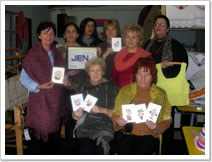 |
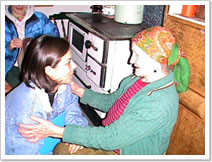 |
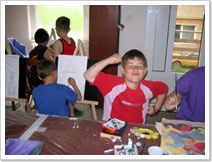 |
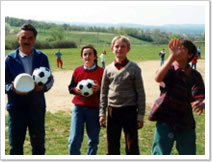 |
Psycho-social Projects (Croatia, Serbia and Montenegro, Bosnia and Herzegovina)
Refugees who do not know if they can ever return to their homes. Returnees who are faced with the harsh reality of rebuilding their lives from scratch. It takes time to overcome the loss of family and possessions from conflict alone; these people were faced with much, much more.
Targeting such people carrying various anxieties and sorrows, we conducted group therapy workshops aimed at psychological care. People from a wide range of age groups attended, and engaged in activities that had the highest number of requests from each community center; for example, knitting, sports, and painting, among others. For those who had stayed locked up inside their homes, the first step is the biggest, and also the most difficult. One aim of these activities was to provide a few moments in the people's lives when they could forget their sorrows. They were able to support each other and share their troubles, as well as information about daily life and repatriation with others who had gone through much like themselves.
Children's Theatre (Croatia)
This was one of the first projects we started in 1994. With the help of a local children's theatre in Osijek, we were able to hold many performances at local refugee/IDP centers, NGO community centers, as well as the children's theatre itself. The parody version of “Little Red Riding Hood” was a great hit among the children, and was able to provide a moment when they could forget the difficult reality of their lives as refugees.
|
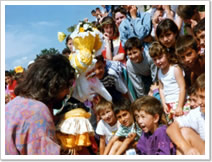 |
Distribution of Dream Bags (Croatia, Serbia and Montenegro, Bosnia and Herzegovina)
Families from all over Japan filled their handmade pouches with toys and stationery, and delivered their “dream bags” to the people in faraway Yugoslavia. The “dream bag deliverers” went to homes in Yugoslavia to hand the people the bags themselves, while at the same time spent time singing and dancing and playing sports with the children. |
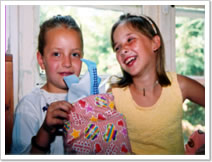 |
Pharmacies and Mobile Pharmacies (Croatia)
The city of Vukovar, located just across the Croatia-Serbia border, was a city of rubble from the heavy fighting that had gone on during the war. From 1994, JEN began medical support as the only NGO in the area, where, due to political reasons, no public medical system existed. In a place where all nearby medical facilities had been destructed, support in the shape of pharmacies was essential to people who needed medication on a daily basis.
Management and Support of Refugee Camps (Croatia)
In 1995, inside UN administered territory along the Croatia-Bosnia border, we managed a transit camp that accommodated Bosnian refugees in cooperation with UNHCR. JEN was the only NGO working in the area at the time. We took on many tasks within the camp, which housed more than 600 refugees, including distribution of food and sanitary goods, repairing of toilets and showers, setting up tents, and managing clinics, among others.
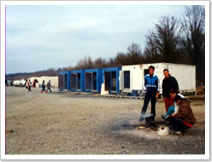 |
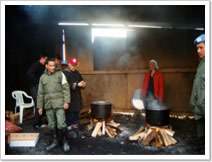 |
Visiting Homes of Elderly Refugees (Croatia)
In Slavonski Brod, a town along the Croatia-Bosnia border, we made several visits with doctors and social workers to homes of elderly Bosnian refugees. We continued our support until 2004, when the last of our initial 300 people receiving our support **was able to return to Bosnia/sadly passed away**. Although quite a number of refugees were able to return to their native Bosnia, many, unfortunately, passed away in a foreign land, far away from their homes.
|
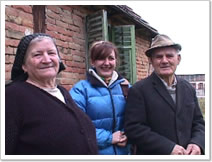 |
Promotion of Ethnic Reconciliation (Bosnia and Herzegovina)
In 1996, a year after the Dayton Accords were signed and when the two entities still remained largely divided, it was not easy for people to go to and fro to visit their homes. During such times of difficulty, we organized art exhibitions and various computer courses, through which people were able to go, albeit temporarily, back to their native lands. From 1997, we hosted summer camps and sports events in which people from different ethnicities participated together.
|
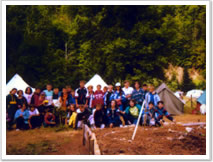 |
Beekeeping Project (Bosnia and Herzegovina)
Amidst the slow but steady flow of repatriation, we conducted programs aimed at generating income, while simultaneously having a peacebuilding/ethnic harmony focus. People from different ethnicities participated in training sessions together, and once completed their training, were given materials (such as beehives) needed to launch the beekeeping project. The Beekeeping Association that was established by the participants themselves managed the shared materials, so that such collaborative work may continue following the completion of the project.
|
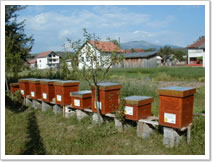 |
Distribution of Livestock (Bosnia and Herzegovina)
In order to accelerate repatriation and resettlement in Sipovo, a place that experienced heavy fighting and destruction during the war due to its location between the two entities, we distributed various livestock as a means for generating income. Livestock was chosen to be distributed, as the local people already had knowledge and skills from before the war. Goats, sheep, cattle or pigs were distributed depending on each person's needs.
|
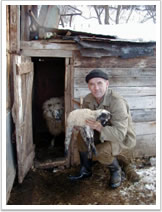 |
Microcredit (Serbia and Motenegro)
In order for the refugees to lead self-supported lives while making full use of their skills and experienc es at the same time, we made small scale loans with no-interest in accordance with each person's needs. From carpentry to auto repairing, beekeeping, poultry farming and monumental masonry, people began working once again, and their joy in being able to support themselves and their family was beyond words.
|
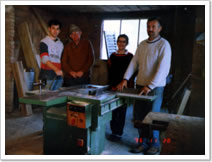 |
Temporary Housing
The many Albanians that returned to their homes after the NATO bombings, found their native land completely destroyed. With the harsh Kosovo winter approaching, where temperatures fall under 0 in October accompanied by heavy snowfall, there was deep concern over how people who had lost their homes would be able to survive through it.
Given the circumstances, we set up 200 temporary housings that were used in the Kobe earthquake around Deçani/Dečani , an area in northwestern Kosovo that had suffered particularly serious destruction. The returnees were able to pass the winter in these housings while repairing their homes.
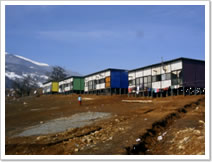 |
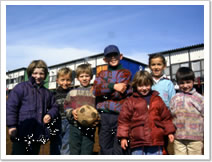 |
Distribution of Sanitary Goods to Kosovar IDPs
We distributed sanitary goods to IDPs that had fled Kosovo to Montenegro. While aid flooded into neighboring Macedonia and Albania, where many refugees had fled, few organizations had provided relief aid in Montenegro. Another difference in our approach to relief provision was in the way we obtained our materials; we chose to purchase our relief goods within Serbia and Montenegro rather than in Europe or the US, as most international organizations had done. In this way not only were we able to provide speedy relief, but also generate positive economic effects in the local community that had been struggling financially from accepting many IDPs.
|
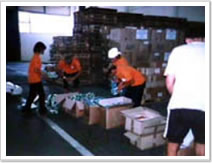 |
Support for Occupational Training Scholarships
We provided support for occupational training scholarships for refugees who had already secured employment in the area which they had fled. For example, we financially supported people to obtain bus driving licenses, which had high demand at the time.
Basic Information
| Country Name | Bosnia and Herzegovina |
| Capital | Sarajevo |
| Population | 4,380,000(sources: research in 1991, although the number of the actual population is much less than this number since there are many refugees from nearby countries) |
| Area | 51,000km2( 1/7 of Japan ) |
| Ethnic Groups | Bosnian (48%), Serb (37.1%),Croat (14.3%), other (0.6%) (2000) |
| Languages | Bosnian, Serbian, Croatian |
| Religions | Muslim, Orthodox, Roman Catholic |
| Country Name | Republic of Croatia |
| Capital | Zagreb |
| Population | 4,440,000 (sources: research in 2001) |
| Area | 56,542 km2( 4 times larger than Kyushu ) |
| Ethnic Groups | Croat (89.6%), Serb (4.54%) |
| Languages | Croatian, Serbian, Other |
| Religions | Roman Catholic, Orthodox |
| Country Name | Serbia and Montenegro |
| Capital | Belgrade *Congress and governmental buildings are located in Belgrade, however it is not stipulated in the Constitution. |
| Population | 10,600,000 |
| Area | 102.173 km2( 1/4 of Japan ) |
| Ethnic Groups | Serb, Montenegrin, Albanian |
| Languages | Serb |
| Religions | Orthodox, Muslim, Roman Catholic, Other |
Situation of Conflict
Following the death of President Tito (Josip Broz), who had made efforts in maintaining the federal system of the country, the Federal Republic of Yugoslavia was faced with the transition from communism to democracy as well as a market economy. Such dramatic change in the political and economic systems triggered a sudden social instability.
As a result of this instability, there was a rapid emergence of politicians in each republic who wished to increase their own power by utilizing nationalism, which consequently led to the eruption of conflict. People who had been living in peace with one another were forced into a situation where they had no choice but to fight with those who had long been their neighbors. It is said that 2,000,000 people were forced from their homes to became refugees or IDPs (Internally Displaced Peoples), losing everything, and left with many traumas.
Local Needs
In 1994, when JEN began its activities in the former Yugoslavia, the conflict in Bosnia Herzegovina was still raging, and there were many refugees in both Croatia and Serbia Montenegro. Holding fears that they “would not be able to return home” in their protracting lives as refugees, the refugees were in need of psychological care and assistance for self support.
After the peace accord that was signed in December 1995, many refugees and IDPs began to resettle in Bosnia. Needs to rebuild people's lives therefore were high, as well as promote the return of minorities.
In 1998, with the intensification of the Kosovo conflict, new refugees and IDPs emerged. This was only exacerbated with the NATO bombings, as more and more people newly became refugees or IDPs in areas where aid was seldom.
Even after the latter half of 1999, when the conflict had finally died down, problems remained in abundance: the reestablishment and reconstruction of a land completely destroyed, the resettlement of returnees, and the settling in of refugees in their respective host countries.


